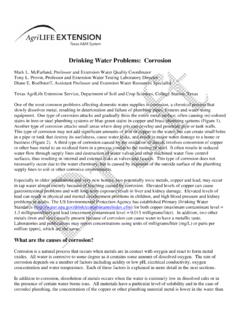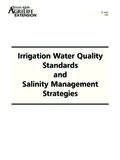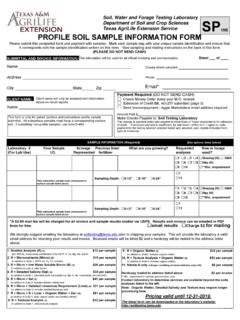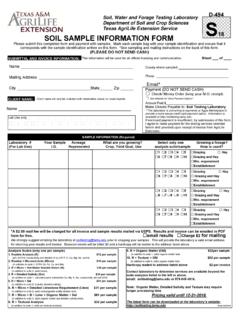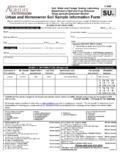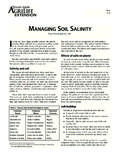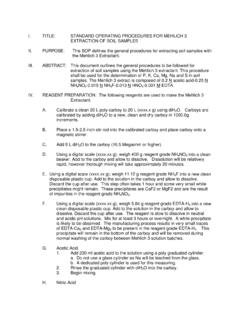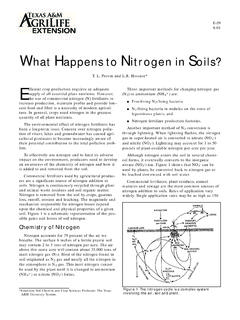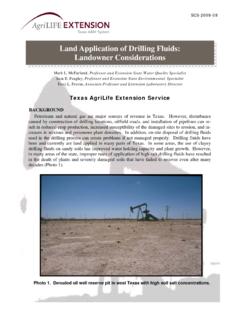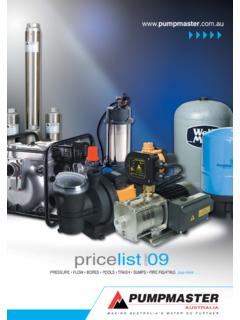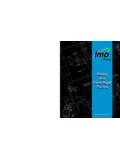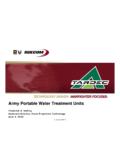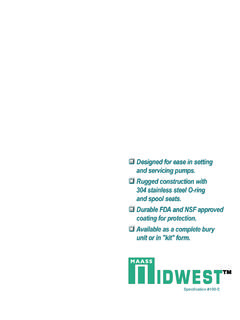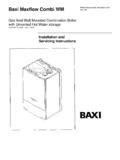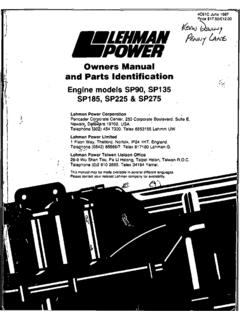Transcription of Soil, Water and Forage Testing Laboratory …
1 Name _____ SAMPLE INFORMATION (Required) (see options listed below) Laboratory # Your Sample Water Source Water Use: (For Lab Use) ID Analyses Public Private Well Pond Lake Stream Processing Plant Other Aquaculture Irrigation-turf Commercial Irrigation-vegetables Domestic Livestock Greenhouse Recreation Hydroponics Other Irrigation- Forage Irrigation-ornamentals 1 2 3 4 5
2 Public Private Well Pond Lake Stream Processing Plant Other Aquaculture Irrigation-turf Commercial Irrigation-vegetables Domestic Livestock Greenhouse Recreation Hydroponics Other Irrigation- Forage Irrigation-ornamentals 1 2 3 4 5 Public Private Well Pond Lake Stream Processing Plant Other Aquaculture Irrigation-turf Commercial Irrigation-vegetables Domestic Livestock Greenhouse Recreation Hydroponics Other Irrigation- Forage Irrigation-ornamentals 1 2 3 4 5 Soil, Water and Forage Testing Laboratory Department of Soil and Crop Sciences Texas A&M AgriLife Extension Service Water SAMPLE INFORMATION FORM Please submit this completed form and payment with samples.
3 Mark each sample bottle with your sample identification and ensure that It corresponds with the sample identification written on this form. *See sampling and mailing instructions on the back of this form. (PLEASE DO NOT SEND CASH) CLIENT NAME: Name _____ Mailing Address _____ City _____State___ Zip _____ County where sampled _____ Phone _____ Email*_____ SUBMITTAL AND INVOICE INFORMATION: This information will be used for all official invoicing and communication. Sheet ___ of ____Client name will only be included with information above on result reports.
4 1. Routine Analysis (R) (201) $25 per sample (Conductivity, pH, Na, Ca, Mg, K, CO32-, HCO3-, SO42-, Cl-, P, B, Nitrate-N. Hardness, and SAR) 2. R + Metals (202) $40 per sample In addition to Routine Analysis includes: (Zn, Fe, Cu, and Mn) 3. R + Titrate of Drip Irrigation (203) $33 per sample4. R + Metals + Titrate for Drip Irrigation (204) $47 per sample5.
5 R + Metals + Heavy metals and Fluoride (205) $75 per sample In addition to test number 2, includes As, Ba, Cr, Cd, F, Ni, Pb. Hardcopy mailed to address listed above $2 per invoice The latest form can be downloaded at the Laboratory s website: The Laboratory s website provides access to multiple Water use and Water quality publications. Contact Laboratory to determine services available beyond the suite analyses listed to the left or above. Pricing valid until 12-31-2019.
6 FormW1-011 CLab Use only *A $ mail fee will be charged for all invoice and sample results mailed via USPS. Results and invoice can be emailed in PDF form for free. email results Charge $2 for mailing We strongly suggest emailing the Laboratory at prior to shipping your samples. This will provide the Laboratory a valid email address for returning your results and invoice.
7 Bounced emails will be billed $2 and a hardcopy will be mailed to the address listed above. W19 CPayment (DO NOT SEND CASH) Check/ Money Order (keep your receipt) Extension of Credit-Bill, AG-257 submitted (page 3) Prepayment on Aggie Marketplace Payment Order Number_____ Amount Paid $_____ Make Checks Payable to: Soil Testing Laboratory Samples will not be processed if payment is not received or a valid AG-257 is not on file with Texas A&M AgriLife Extension Service. How To Take A Water Sample Water analyses can only be accurate if the sample is taken correctly.
8 When collecting a Water sample, please follow these simple guidelines: CONTAINERS Samples should be collected in a new clean, plastic bottle with a screw cap. Purchased 16-20 ounce drinking Water bottles can be reused if you rinse the bottle three times with the Water source to be submitted to the Laboratory . Insure the cap is tight prior to shipping. Please note that the lab does not test for bacteria, pesticides, or petrochemicals. Clearly identify each bottle with a simple sample matching those used on the front side of this form.
9 When mailing, place bottles in a box and pack with a loose, soft packing material to prevent crushing. Avoid glass containers, as boron concentrations may change, and glass has higher potential for breakage. AQUACULTURE Provide as much information as possible about the condition of the pond. If fresh Water is running into the pond, collect the sample in the area of the pond least affected by the fresh Water . When samples are taken from salt- Water ponds where fresh Water may have been added, gather Water from both the top and bottom of the pond.
10 The lab cannot test for dissolved oxygen, free carbon dioxide, or hydrogen sulfide, even though these criteria all affect fish mortality. These substances must be tested for on-site, and kits for conducting these tests are commercially available. WELL Water Let the pump operate ten minutes to an hour before taking the sample. Take the sample as close to the pump as possible. ASSESSING PROBLEM WATERS Two separate Water samples may be required to address Water related problems due to plumbing and/or fixtures. One sample should be collected at the point of entry (well or Water service) and another at point of use (faucet, pool and etc.)
